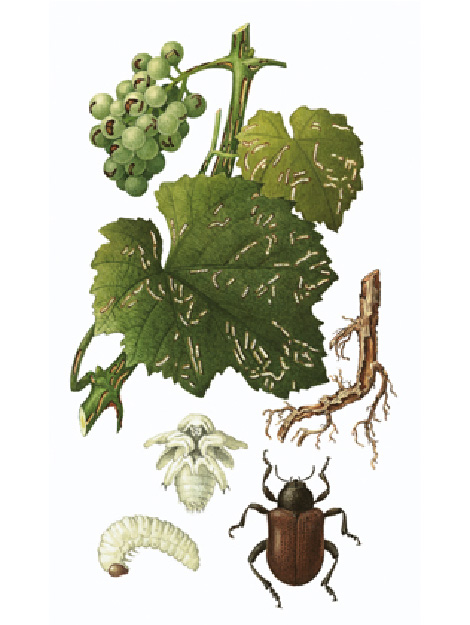Western grape rootworm
Bromius obscurus
Appearance
The leaf beetle, 5-6 mm in size, is brownish-black in color and not shiny metallic. The elytra are broader than the cervical shield and have distinct shoulders, by which the beetles are easily recognized.
The root-dwelling whitish larvae with brown head capsule have three pairs of legs and grow to about 5 mm.

Biology
The vine drop weevil belongs to the leaf beetle family (Chrysomelidae).
The beetles live on the vines from the beginning of May to August. When disturbed, they drop to the ground ("vine drop beetle"). After a maturing feeding period of about two weeks, the females lay eggs in groups of 15-20 in cracks in the old bark or on roots near the surface. After ten to twelve days, the young larvae hatch and feed on the roots. They initially destroy the fine roots and later feed on older roots in spiral tunnels. Root feeding continues into the fall, or it continues during mild winters. Towards the end of winter, pupation occurs just below the soil surface. After about three weeks of pupal dormancy, the beetles hatch in spring.
Damage symptoms
The leaf beetles cause feeding marks on above-ground plant parts such as leaves, shoots and berries, which are about 1 mm wide and 10 mm long and resemble writing characters. Therefore, the vine drop weevil is also called "scribe". From midsummer, the berries may also be gnawed. Symptoms are similar to those of "Oidium seed break" caused by powdery mildew. Secondary fungal infections may additionally damage the gnawed berries.
The larvae feed on the roots of the vines. This causes line disorders, which can lead from stunted growth to the death of the canes.
Prevention and control
- Natural enemies of the vine drop weevil include insectivorous vertebrates but also ants that eat the eggs.
- Plant protection measures to control these leaf beetles are usually not necessary.
- Often, grapevine leaf beetles are included with plant protection measures against other pests.
Last updated: 04.09.2023
automatically translated